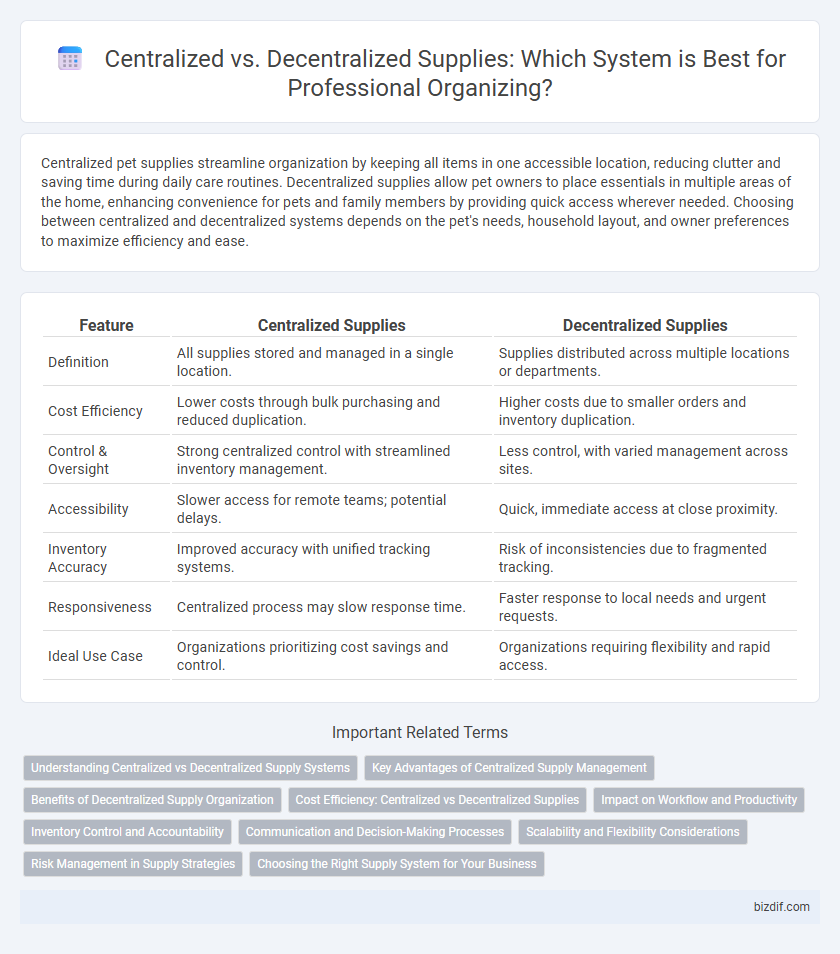Centralized pet supplies streamline organization by keeping all items in one accessible location, reducing clutter and saving time during daily care routines. Decentralized supplies allow pet owners to place essentials in multiple areas of the home, enhancing convenience for pets and family members by providing quick access wherever needed. Choosing between centralized and decentralized systems depends on the pet's needs, household layout, and owner preferences to maximize efficiency and ease.
Table of Comparison
| Feature | Centralized Supplies | Decentralized Supplies |
|---|---|---|
| Definition | All supplies stored and managed in a single location. | Supplies distributed across multiple locations or departments. |
| Cost Efficiency | Lower costs through bulk purchasing and reduced duplication. | Higher costs due to smaller orders and inventory duplication. |
| Control & Oversight | Strong centralized control with streamlined inventory management. | Less control, with varied management across sites. |
| Accessibility | Slower access for remote teams; potential delays. | Quick, immediate access at close proximity. |
| Inventory Accuracy | Improved accuracy with unified tracking systems. | Risk of inconsistencies due to fragmented tracking. |
| Responsiveness | Centralized process may slow response time. | Faster response to local needs and urgent requests. |
| Ideal Use Case | Organizations prioritizing cost savings and control. | Organizations requiring flexibility and rapid access. |
Understanding Centralized vs Decentralized Supply Systems
Centralized supply systems consolidate inventory management within a single location, enabling streamlined procurement, reduced redundancy, and enhanced cost control for professional organizing businesses. Decentralized supply systems distribute supplies across multiple sites, offering quicker access and tailored inventory to specific needs but often at the expense of increased complexity and higher operational costs. Understanding the trade-offs between centralized control and localized flexibility is crucial for optimizing efficiency and responsiveness in professional organizing supply management.
Key Advantages of Centralized Supply Management
Centralized supply management streamlines inventory control by consolidating resources, which reduces redundancy and lowers procurement costs. It enhances accountability through unified tracking systems, ensuring better quality control and compliance with organizational standards. Centralized supplies also improve operational efficiency by enabling bulk purchasing and standardized processes across multiple locations.
Benefits of Decentralized Supply Organization
Decentralized supply organization enhances flexibility by allowing individual departments to manage their own inventory, leading to faster access and reduced bottlenecks. It improves accountability and customization since users can tailor supplies to their specific needs without relying on a central authority. This approach also minimizes the risk of complete supply chain disruptions by distributing inventory across multiple locations.
Cost Efficiency: Centralized vs Decentralized Supplies
Centralized supplies streamline inventory management by consolidating purchases, significantly reducing bulk order costs and minimizing redundancy. Decentralized supplies offer customization and quick access but often lead to higher overall expenses due to duplicate stock and inefficient procurement processes. Businesses prioritizing cost efficiency typically benefit from centralized supply systems that optimize ordering and reduce waste.
Impact on Workflow and Productivity
Centralized supplies streamline workflow by reducing search time and minimizing duplicate inventory, enhancing overall productivity in professional organizing projects. Decentralized supplies offer quick access tailored to specific zones or teams, which can speed up task execution but may lead to inconsistencies and inventory management challenges. Effective organization balances centralized control with decentralized availability to optimize both efficiency and responsiveness in project workflows.
Inventory Control and Accountability
Centralized supplies streamline inventory control by consolidating materials in a single location, enabling accurate tracking and reducing redundancy. Decentralized supplies distribute resources across multiple sites, which can complicate inventory management but improve accessibility and response time. Effective accountability relies on clear protocols and technology to monitor usage regardless of the centralized or decentralized approach.
Communication and Decision-Making Processes
Centralized supplies streamline communication by consolidating requests and approvals through a single point, reducing miscommunication and ensuring consistent inventory oversight. Decentralized supplies empower individual departments to make quicker decisions tailored to their specific needs, enhancing responsiveness but potentially causing dispersed control and duplicated efforts. Efficient decision-making in centralized models relies on clear protocols and real-time data access, while decentralized systems depend heavily on strong interdepartmental communication and coordination to prevent resource overlap.
Scalability and Flexibility Considerations
Centralized supplies streamline inventory management, enhancing scalability by allowing bulk purchasing and consistent resource allocation across multiple projects or locations. Decentralized supplies offer greater flexibility, enabling teams to quickly adapt to local needs and reduce dependency on a single supply source. Balancing centralized control with decentralized responsiveness supports efficient growth and dynamic organization in professional organizing environments.
Risk Management in Supply Strategies
Centralized supplies streamline procurement processes, reducing risks related to inconsistent inventory and supplier reliability through consolidated oversight and bulk purchasing power. Decentralized supplies enhance flexibility and local responsiveness, mitigating risks associated with supply chain disruptions by distributing inventory closer to end-users. Effective risk management in supply strategies balances centralized control with decentralized agility to optimize inventory availability and minimize operational interruptions.
Choosing the Right Supply System for Your Business
Choosing the right supply system for professional organizing hinges on the scale and structure of your business; centralized supplies streamline inventory management and reduce costs by consolidating materials in one location. Decentralized supplies offer flexibility and immediate access at multiple job sites, enhancing responsiveness and client satisfaction. Assessing factors like project volume, geographic distribution, and budget constraints ensures an optimized, efficient supply system tailored to your organizational needs.
Centralized supplies vs Decentralized supplies Infographic

 bizdif.com
bizdif.com